|
|
Post by kiwithrottlejockey on Oct 31, 2013 15:53:53 GMT 12
From the Los Angeles Times....Kepler-78b: This scorched planet is more like Earth than you thinkBy AMINA KHAN | 7:58PM PDT - Thursday, October 30, 2013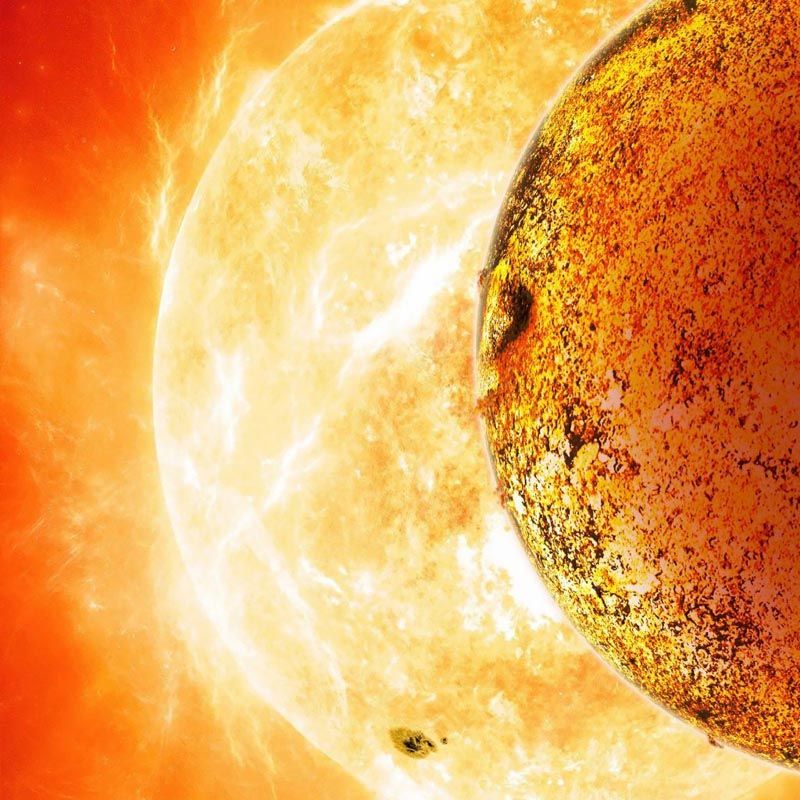 This artist's rendition released by NASA shows Kepler-78b orbiting its parent star. — Picture: David A. Aguilar/NASA.ASTRONOMERS have discovered a world that is incredibly close to Earth-sized and may also be made of rock and iron, like our own planet. The only problem? It’s a scorched hellscape of molten lava that sits less than a million miles from its star’s surface, and it shouldn’t exist in the first place. This artist's rendition released by NASA shows Kepler-78b orbiting its parent star. — Picture: David A. Aguilar/NASA.ASTRONOMERS have discovered a world that is incredibly close to Earth-sized and may also be made of rock and iron, like our own planet. The only problem? It’s a scorched hellscape of molten lava that sits less than a million miles from its star’s surface, and it shouldn’t exist in the first place.
This planet defies astronomers’ expectations even as it lends hope that increasingly Earth-like planets may be found (though hopefully farther away from their parent stars, in more bearable climes).
"For the first time we have something pretty close to the size of the Earth that has the same density as the Earth," said astronomer David Latham of the Harvard-Smithsonian Center for Astrophysics, one of the coauthors of one of two studies published in Nature.
The planet, named Kepler-78b, "foreshadows leaps forward in the search for life beyond the solar system," Drake Deming, an astronomer at the University of Maryland at College Park who was not involved in the paper, wrote in a commentary.
Kepler-78b has a mass that’s 80% greater than Earth’s and a radius that’s only 20% longer, which comes out to a density that nearly matches Earth’s density of 5.5 and makes it "a virtual twin of Earth by astronomical standards," Deming wrote.
But the planet defies theoretical expectations for how planets formed. Scientists really aren’t sure how it got there, given that its parent star was bigger when it was younger. If the planet had formed where it is today, it would have been inside the star.
"That doesn’t work — so it would have to form further away from the star and then gradually migrate its way in to where it is now," Latham said. "But that’s got a bit of a problem too because it’s so close."
The planet is doomed, he added. In a few hundred million years, "it’ll get swallowed by the star."
The rocky planet was discovered using the Kepler Space Telescope, which until its recent crippling would stare at a single patch of the heavens, waiting for dips in starlight that meant a planet was crossing in front of its star.
Finding such a small planet is a challenge. But because the planet is so close to its star, it completes a full orbit in just 8.5 hours, and its many transits in a short amount of time made it easier to pick out.
Figuring out its mass (and density) was another challenge. That requires a whole other technique called radial velocity, which uses the Doppler effect to measure the little wobbles in the star caused by the planet’s gravitational tug. This wobble causes the star’s light to stretch to redder wavelengths and squeeze to bluer ones, and scientists can pick out this red shift and blue shift and determine how big the troublesome planet must be.
Using data from the HARPS-N instrument on the Galileo National Telescope in Italy, the researchers were able to determine this planet’s mass (and thus the density), but it’s too difficult to use the radial velocity technique to find mass for every planet they’ve found using Kepler, Latham said.
"The Doppler measurements will be the bottleneck for the foreseeable future," Latham said.
But they do hope it’s the start of something.
"The existence of Kepler-78b shows that, at the very least, extrasolar planets of Earth-like composition are not rare," Deming said.www.latimes.com/science/sciencenow/la-sci-sn-kepler-78b-earth-like-planet-size-mass-density-20131030,0,2264044.story
|
|
|
|
Post by kiwithrottlejockey on Nov 6, 2013 21:56:23 GMT 12
from the Washington Post....Kepler space telescope finds Earth-size, potentially habitable planets are commonBy JOEL ACHENBACH | Tuesday, November 05, 2013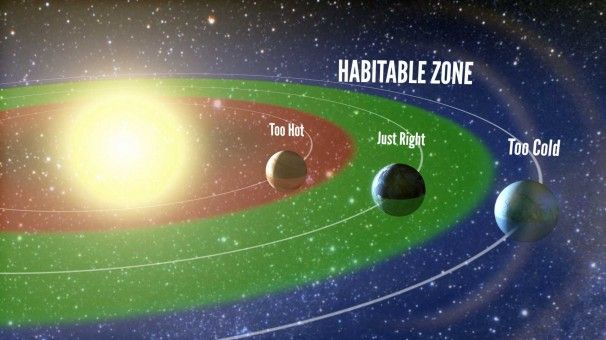 CLICK IMAGE TO VIEW VIDEO: One in every five sunlike stars is orbited by a potentially habitable CLICK IMAGE TO VIEW VIDEO: One in every five sunlike stars is orbited by a potentially habitable
planet, according to a new analysis of observations by NASA’s Kepler space telescope. Video
courtesy of Erik Petigura/University of California at Berkeley; Andrew Howard/University of
Hawaii at Manoa; Geoff Marcy/UC-Berkeley; Illumina Studios, Emeryville, California.ROUGHLY one in every five sunlike stars is orbited by a potentially habitable, Earth-size planet, meaning that the universe has abundant real estate that could be congenial to life, according to an analysis of observations by NASA’s Kepler space telescope.
Our Milky Way galaxy alone could harbor billions of rocky worlds where water might be liquid at the surface, according to the report, which was published Monday in the Proceedings of the National Academy of Sciences and discussed at a news conference in California.
If the estimate is correct, the nearest ocean planet might be just 12 light-years away, which, though extremely distant for all practical purposes (such as sending a robotic space probe), is just around the corner in our galactic neighborhood.
“When you look up at the stars in the night sky, how many of them have a planet like the Earth?” asked Erik Petigura, a graduate student at the University of California at Berkeley and the lead author of the paper. “We’re able to start answering this question.”
The best estimate is 22 percent of stars like our own, with an error margin of plus or minus eight percentage points.
“Earth-sized planets having the temperature of a cup of tea are common around sunlike stars,” said planet hunter Geoff Marcy, a Berkeley astronomer and a co-author of the study. He said the finding “represents one great leap toward the possibility of life, including intelligent life, in the universe.”
Kepler, launched in 2009, is no longer able to search for “exoplanets” — outside our solar system — because it has been unable to point with precision after the failure of a steering mechanism this year. But the telescope amassed more than three years of observations before going on the blink. Kepler mission scientist Natalie Batalha said there is still another full year of data to rummage through.
The telescope’s original mission was to obtain an estimate of the percentage of stars with potentially habitable planets, and this latest analysis comes close to meeting that goal. This is still an extrapolation of data and is not the same thing as taking a careful census of these Earth-size planets directly, said Sara Seager, an astrophysicist at MIT who was not directly involved in the new analysis.
“Earth-size” doesn’t necessarily mean “Earth-like,” Seager noted. But she said this result will boost efforts to build telescopes that could obtain direct imagery of one of these extremely distant worlds.
“Earth-sized planets are not rare, so we’ll know we’ll have stuff to look at,” Seager said. “It’s reassuring for us."
Jill Tarter, a pioneer in “SETI,” the search for extraterrestrial intelligence, said in an e-mail: “We haven’t yet found Earth 2.0, but these statistics suggest that it should be forthcoming, and soon. When we can point to Earth 2.0 in the sky, it will seem completely natural to ask ‘Does anybody live there?’ and ‘Can we go there?’ I think Earth 2.0 will concretize SETI as nothing else has.”
Kepler studied 150,000 stars in a small patch of the sky in the constellation Cygnus. The planets surrounding distant stars cannot be seen directly, because their faint, reflected light is swamped by the much brighter starlight. Thus Kepler looked for the periodic dimming of a star, which could be the signal of a planet passing across the star’s face. Ground-based telescopes, such as the Keck I in Hawaii, helped produce an estimate of the size of these transiting planets.
The Kepler team has found amid the space telescope’s data 10 “candidate” planets that, while not confirmed, appear to be roughly one to two times the mass of Earth and orbiting at “Goldilocks” distances, neither too close nor too far from the stars.
The scientists extrapolated in two ways. They know that most planets are unlikely to be in orbits that, just by chance, cause them to pass in front of the face of the star as seen from Kepler. That’s a 1-in-100 long shot. For every planet seen, multiply by 100.
The scientists also knew that some planets would remain difficult to detect because of natural fluctuations in starlight — the “noise” in the signal. They found a way to test the accuracy of the algorithms for detecting planets by inserting 40,000 “synthetic” planets into the computer programs and seeing how many would be accurately retrieved by those programs.
The analysis does not prove that any of these “habitable zone” planets resemble Earth. The report states only that they are roughly the size of our planet and are not too close or too far from the star for water — if it is present — to be liquid at the surface.
Moreover, being in a star’s habitable zone does not ensure that life will spring forth. Scientists have limited understanding of the origin of life on Earth. The Earth has a number of features that are amenable to life and that might not be common, including a nearly circular orbit, a large companion moon and tectonic activity that recycles the planet’s carbon.
Kepler has found 3,538 candidate planets, Jason Rowe, a research scientist at the SETI Institute, said at the news conference Monday. Of those, 647 are Earth-size, 104 are in the star’s habitable zone and 10 meet both criteria.
William Borucki, the principal investigator for Kepler, noted that some of the larger planets in the habitable zone might have moons amenable to life. “All of those 104, I think, are very interesting planets,” Borucki said.
If the new estimate is correct, there should be about 25 billion Earth-size planets in habitable zones in our galaxy, by Borucki’s calculation.
“Those numbers are pretty soft,” he said. “We have a lot of corrections to make before we have really definitive numbers.”
Monday’s news can be viewed as progress in filling in numbers in the famous Drake Equation, developed in 1961 by astronomer Frank Drake as a way of estimating the abundance of communicative civilizations.
“It’s encouraging,” Drake, a senior astronomer at the SETI Institute, said Monday. “It gives us a number, and it’s a number we can stick into the equation.”
He said other factors in the Drake Equation remain highly uncertain — in particular, the evolutionary probability of intelligence.www.washingtonpost.com/national/health-science/kepler-space-telescope-finds-earth-size-potentially-habitable-planets-are-common/2013/11/04/49d782b4-4555-11e3-bf0c-cebf37c6f484_story.html
|
|
|
|
Post by kiwithrottlejockey on Nov 13, 2013 12:54:49 GMT 12
 40 billion ways to danceBy Mark Morford, SF Gate Columnist | Tuesday, November 12, 2013EVERY DAY it’s the same: At any given moment, someone, somewhere is discovering something either quiet or grand, miniscule or momentous, that changes the way we think, the way we hold space, the way we perceive the mind, the world, the galaxy and even reality itself, to the point where we will likely never be the same again. 40 billion ways to danceBy Mark Morford, SF Gate Columnist | Tuesday, November 12, 2013EVERY DAY it’s the same: At any given moment, someone, somewhere is discovering something either quiet or grand, miniscule or momentous, that changes the way we think, the way we hold space, the way we perceive the mind, the world, the galaxy and even reality itself, to the point where we will likely never be the same again.
Even better? This stunning flow of ideas and discoveries, debunkings and feral potentialities is not the slightest bit linear. It is, instead, as the mystics and gurus have known for millennia, a leaping, looping, lurching thing, jumping up and spitting divine fire before folding back on itself, only to ignite anew and singe the eyebrows of your jaded and wary soul.
Do you recognize it? It’s nothing short of the cosmic dance itself, the ceaseless winking of Shiva’s third eye, a trickster angel with Tourette’s and a flamethrower.
Behold, the Kepler spacecraft. Its foremost (and now defunct, as it sadly broke down late last year) duty: rabid and fast-panting calculations of the stars in our tiny galaxy, in the hopes of calculating just how many might have stable, rocky planets swirling around them that might be similar to, well, Earth. You are here.Kepler’s initial conclusion, when combined with what astronomers have already discovered? Somewhere around 4,500 planets, with one in particular — the recently discovered Kepler 78b — having the same density and orbit speed (but alas, not the same temperature) as our own pale blue speck. You are here.Kepler’s initial conclusion, when combined with what astronomers have already discovered? Somewhere around 4,500 planets, with one in particular — the recently discovered Kepler 78b — having the same density and orbit speed (but alas, not the same temperature) as our own pale blue speck.
It’s a stunning finding, which floored astronomers and ignited all sorts of glorious debate about What It All Might Mean. A hot little gem of a planet right here in our very own galaxy, one that meets most of the Drake equation, the formula used to calculate potential Earthiness? Plus thousands more like it somewhere out there in deep space? Fantastic. Awesome. More than enough to set curious souls newly aflame.
But of course, that was just the beginning. Along comes a hard-workin’ Berkeley grad student by the name of Erik Petigura to really crunch Kepler’s numbers, and write a paper exclaiming how that 4500 number is, well, probably more than a few zeros short.
That’s right: the actual number of potential Earths is closer to 40 billion — that’s one in every five stars, just in our galaxy alone — with that number possibly much higher (Kepler is reportedly very sorry it conked out too soon to tell us more).
Holy WTF, humble biped. That will do nicely, no? This is quite sufficient to rip the bodice off our naive understanding and completely ravish our sense of awe, especially when you consider that one of those 40 billion stars might actually be close enough — just 12 light years away — to see with the naked eye, from wherever you are, in whatever outfit you’re wearing right now, in whatever scientific posture you prefer to take.
Go ahead, try it. Step outside tonight and glance skyward, pick any star and then visualize its own rocky, Earthy little ball orbiting around it, with some form of life potentially dancing a tango on top. Go ahead and multiply that awesome possibility by 40 billion, and then multiply that number exponentially, into the other billions of galaxies beyond our humble Milky Way. Feel free to pour copious amounts of wine as you do this – it’s going to be a dizzy ride.
Did it work? Did you quickly fall over in a sloppy, giggling heap as your ferociously limited mind shut off somewhere around a million and change, simply could not compute all that vast possibility, leaving you to swoon to the core at the grand, cosmic absurdity of this life, at the idea that we think we have a clue as to how it all works, and why it’s all there, and what sort of grumpy, homophobic grandfather figure snapped his arthritic fingers and set it all in motion?
What a grand slap upside the head! How wonderful to be a part of this constant and ongoing explosion of our supposed reality, the eternal flux and burp of divine wisdom, consciousness refusing to hold still even for a second because it simply cannot, and never will! Who wants wine?
Do not misunderstand. It’s all sorts of fun to think the odds are now overwhelming that one (or even one billion) of those planets is almost certainly home to some form of life, that some of that life is almost certainly intelligent and we might someday have sufficient technology to attempt to visit one of those planets and shake tentacles with some aliens. After all, it’s the height of human hubris to believe we’re the best the cosmos can do in terms of sex-obsessed monkeys with too many guns and not enough compassion.
But let’s go a little wider. Further in. Right to the heart of our understanding that the minute we think we know something, the minute we have the nerve to declare a truism about life, the galaxy, love or time is the minute the goddess laughs and sheds another veil.
Maybe you feel it, too? Maybe you apply this lesson to your own life, every day, in how you move and breathe and offer forth? Think you know how it’s all supposed to look, feel, move and dance? How adorable you are.Put it this way: Every certainty contains the need for its own demise. Every human conviction is but an impudent taunt to the gods, a petulant child claiming he is king of the swing-set, ignoring that “king” is a worthless construct and swing-sets were invented by dark matter five trillion years ago. Think you know how it’s all supposed to look, feel, move and dance? How adorable you are.Put it this way: Every certainty contains the need for its own demise. Every human conviction is but an impudent taunt to the gods, a petulant child claiming he is king of the swing-set, ignoring that “king” is a worthless construct and swing-sets were invented by dark matter five trillion years ago.
Which is to say, it’s just another divine opportunity for radical release, to realize “facts” are but playthings, guidelines, pointers, designed to be blown open and re-digested, over and over, never to be held for long lest they turn toxic and lethal. Isn’t that right, Catholic church?
As it is with the universe, so it is with you, me, us. Think you got it down? Think you know who you are, who I am, what you’re all about, and your spouse and family too? Got all the facts you need, politics, pet peeves, sports team, narrow ideology, religious tremors, a fine set of stiff little convictions about what kind of person you are and always will be? Good for you. I got 40 billion reasons to call bullshit.
Truth is, there’s really only one appropriate response to Petigura’s findings, and all findings like it, from Galileo to the Higgs Boson, from the dawn of consciousness to the most luminous moments of deep meditation.
It comes from one Geoffrey Marcy, the (understandably) excited, planet-hunting UC Berkeley astronomer who oversaw Petigura’s research, and helped write the paper. And it is, when all is said and done, the only honest response you can ever really have when face to face with the Great Mystery.
“I’m feeling a little tingly,” he said.• Email: Mark Morford• Mark Morford on Twitter and Facebook.blog.sfgate.com/morford/2013/11/12/40-billion-ways-to-dance |
|
|
|
Post by kiwithrottlejockey on Dec 4, 2013 19:11:29 GMT 12
From the Los Angeles Times....Hubble finds water on 5 planets in our galactic neighborhoodBy DEBORAH NETBURN | 4:06PM PST - Tuesday, December 03, 2013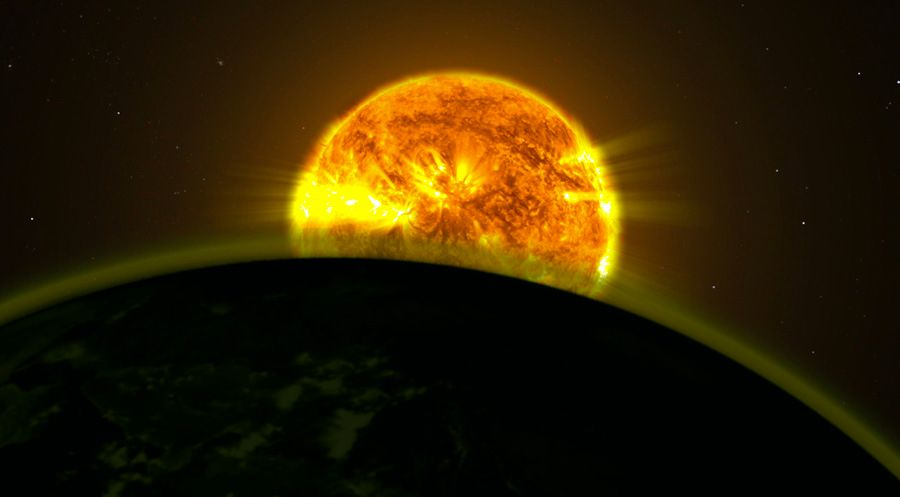 Scientists using the Hubble Space Telescope have found evidence of water vapor in the atmosphere of five exoplanets. Scientists using the Hubble Space Telescope have found evidence of water vapor in the atmosphere of five exoplanets.
— Photo: NASA's Goddard Space Flight Center.THANKS TO the Hubble Space Telescope and some new imaging techniques, scientists have detected traces of water vapor on five massive planets right in our galactic backyard.
But if you just thought "Life?!" think again. Despite the presence of water molecules in their atmospheres, none of these five planets is suitable to life as we know it. They are all gas giants, sometimes called hot-Jupiters, and they are all too close to their suns to sustain liquid water on their surfaces.
These planets — WASP-17b, HD209458b, WASP-12b, WASP-19b and XO-1b — are tidally locked with their stars so that the same side of the planet always faces the star and is constantly bombarded with a powerful stream of solar radiation. The heat from the star is distributed around the planet via strong winds that move faster than the speed of sound.
"They are very violent places," said L. Drake Deming, an astronomer at the University of Maryland who recently led a census of exoplanet atmospheres.
To find traces of water vapor in their atmospheres, Deming and his colleagues used Hubble's Wide Field Camera 3, which measures near-infrared light. The scientists waited until each planet was about to pass in front of its sun, then pointed Hubble at it. Because water molecules absorb certain wavelengths of light, the scientists could detect the presence of water vapor during the planet's transit across its sun if those wavelengths were not picked up by Hubble.
Deming said that finding water vapor on these planets was not a surprise. Indeed, he would have been surprised if he hadn't found it.
"It was consistent with what we expect," he said. "But it is one thing to say these planets should have water vapor and it's another thing to actually measure it."
Hubble is only strong enough to see the signs of water vapor on the gas giant planets, but Deming said that Hubble's successor — the James Webb Telescope, slated to launch in 2018 — will be strong enough to find water signatures in the atmospheres of smaller, rockier planets more like Earth.
"The James Webb Telescope would allow us to extend these measurements to habitable Earth-like planets, maybe twice as big as Earth, and in the habitable zone where water could condense," he said.
In the meantime, Deming and his team want to determine the most accurate way to measure the presence of water on planets trillions of miles away, and the hot-Jupiter planets make good test cases. Because they are so close to their host stars, most of them take just days to complete a full orbit, offering scientists frequent opportunities to take measurements.
"It wouldn't be a bad analogy to say these planets are the astronomical equivalent of fruit flies," he said."The grand challenge is to find another habitable Earth-like planet, but the focus of my work is to put these measurements on a really sound basis."www.latimes.com/science/sciencenow/la-sci-sn-hubble-finds-water-on-5-planets-20131203,0,1063198.story
|
|
|
|
Post by kiwithrottlejockey on Dec 15, 2013 16:21:28 GMT 12
From the Los Angeles Times....Study moves planet Earth safely off the edge of its habitable zoneBy AMINA KHAN | 6:00AM PST - Friday, December 13, 2013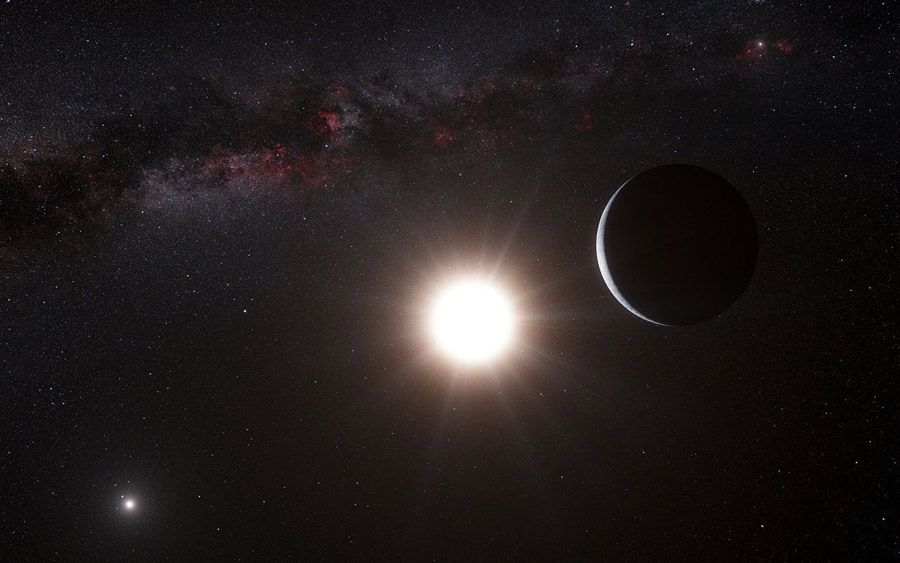 This artist's representation shows a planet, right, orbiting the star Alpha Centauri B, center, a member of the triple star system that is closest This artist's representation shows a planet, right, orbiting the star Alpha Centauri B, center, a member of the triple star system that is closest
to Earth. This exoplanet sat too close to its star for liquid water to exist. Now, scientists say a star's habitable zone might stretch a little bit
closer in, which could alter the way researchers hunt for planets. — Picture: L. Calcada/European Southern Observatory.THE habitable zone around sun-like stars might be a little wider — or thinner — depending on how big you thought the habitable zone was in the first place, suggests new research in the journal Nature.
The findings, based on 3-D models of the runaway greenhouse gas effect, may alter the estimated number of habitable planets around sun-like stars in our galaxy — and they may also may affect how future planet-hunting space telescopes are designed and built.
The habitable zone is the doughnut-shaped "Goldilocks" region around a star where a planet would be warm enough to have liquid water and cool enough to keep it from evaporating away. In the sun’s case, Earth sits near the inside boundary of the habitable zone, and cold Mars sits closer to the far end of it. Gassy, super-hot Venus sits so close to the sun that it experienced a runaway greenhouse effect early in its history and whatever water may have existed has long since evaporated.
Researchers wonder when the same thing might happen to Earth, as the sun grows hotter and our planet warms over the eons.
“This destabilizing greenhouse feedback can 'run away' until the oceans have completely evaporated,” the study authors wrote.
Other scientists using data from NASA’s now-crippled Kepler space telescope have estimated that 22% of sun-like stars in the Milky Way have an Earth-size planet in the habitable zone, which — depending on how many sun-like stars are in the galaxy, 50 billion or 100 billion — comes out to as many as 22 billion potential Earth-like planets.
But those scientists estimated the habitable zone of a sun-like star to be from 0.5 of an astronomical unit — half the distance from the sun to Earth — to 2 astronomical units, or AU, James Kasting and Chester Harman of Penn State University wrote in a commentary on the Nature paper.
“This is a curious choice, because the completely desiccated planet Venus orbits at 0.72 AU, suggesting that the habitable-zone inner edge is somewhere beyond that distance,” Kasting and Harman wrote, noting that bone-dry Venus clearly isn’t habitable.
Other estimates tried to model at what point water would start to fill upper layers of the atmosphere and get burned off by the sun — a phenomenon known as "moist greenhouse" — and at what point all the water would simply evaporate from the oceans and fill the air with moisture. Neither of these scenarios are good for life. That previous research put the habitable zone at about 0.99 AU, which would mean that Earth, at 1 AU, is perhaps a little too close to the warmer inner edge of the habitable zone.
But these previous models have relied on one-dimensional models of the atmosphere. The current study uses a three-dimensional model that takes into account factors like clouds and variations in relative humidity.
Ultimately, the authors of the Nature paper put the inner edge of the habitable zone — the edge closer to the sun — at 0.95 AU. The difference, 0.04 AU, doesn’t sound like much, but comes out to 3.7 million miles — and it gives Earth a decent amount of breathing room.
“This has strong implications for the possibility of liquid water existing on Venus early in its history, and extends the size of the habitable zone around other stars,” the Nature study authors wrote.
But it also means that the estimated 22 billion Earth-like planets around sun-like stars, based on a minimum distance from the sun of 0.5 AU, “could be too high by a factor of almost 2,” Kasting and Harman said.
This means future telescopes would have to focus on the planets farther from their stars, which take longer to orbit their star and thus take more time to pin down. The findings could have implications for how future telescopes are designed, the commentators said.
“This difference is important because a smaller value … implies that a future space telescope designed to observe and characterize such planets must be correspondingly larger,” Kasting and Harman wrote.www.latimes.com/science/sciencenow/la-sci-sn-exoplanet-habitable-zone-planet-earth-greenhouse-gas-20131211,0,4052692.story
|
|
|
|
Post by kiwithrottlejockey on Jan 2, 2014 16:29:50 GMT 12
From the Los Angeles Times....Hubble Space Telescope finds clouds on super-Earth, Neptune-sized planetsBy AMINA KHAN | 4:22PM PST - Tuesday, December 31, 2013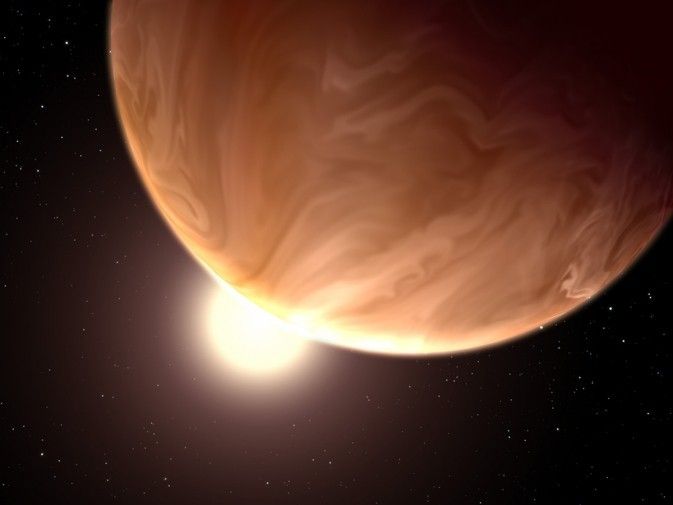 An artist's interpretation shows a cloudy exoplanet with its home star in the background. Data from the Hubble An artist's interpretation shows a cloudy exoplanet with its home star in the background. Data from the Hubble
Space Telescope show that warm Neptune GJ 436b and super-Earth GJ 1214b may have high-altitude clouds
covering their atmospheres. — Picture: Space Telescope Science Institute.USING Using NASA’s Hubble Space Telescope, two research teams have discovered thick layers of high-altitude clouds covering the atmospheres of two relatively nearby exoplanets: a super-Earth and a "warm Neptune."
Scientists are beginning to get a handle on how to study the atmospheres on alien planets, and have even found green clouds on the super-Jupiter planet, Kepler-7b. But the findings, published in the journal Nature this week, show that clouds can cover smaller planets too — including two of the most common types of planets found in the Milky Way.
Neither of the planets, GJ 436b and GJ 1214b, are quite like anything found in our solar system. GJ 436b is a warm Neptune that’s slightly larger than Neptune and much closer to its host star. Thus unlike our own distant, gassy ice giant, GJ 436b’s surface temperature sits about a blistering 980 degrees Fahrenheit. It is 36 light-years from Earth in the constellation Leo. GJ 1214b, a super-Earth whose radius is 2.7 times that of our home planet, sits about 40 light-years away in the constellation Ophiuchus.
"Super-Earth and Neptune-class planets collectively represent an intriguing and populous type of extrasolar planet whose exotic atmosphere may have no true analogies in the solar system," Julianne Moses of the Space Science Institute in Boulder, Colorado, who was not involved in the research, wrote in a commentary on the papers.
To look at their atmospheres, the researchers wait for the planet to cross in front of its star and look at the starlight filtering through the backlit planet’s thin layer of atmosphere. They usually look for dips in certain wavelengths of light — a luminous fingerprint caused by chemicals in the atmosphere, which would reveal what the planet’s shell of air was made of.
But for these planets, they found no such chemical fingerprint imprinted on the light. The most likely reason, the researchers surmised, would be a layer of high-altitude clouds blocking the view.
"However, high-altitude clouds on these two exoplanets would not resemble the clouds we see in the solar system," Moses wrote. "Possible candidates include potassium chloride or zinc sulphide ‘dust’ clouds."www.latimes.com/science/sciencenow/la-sci-sn-clouds-super-jupiter-warm-neptune-exoplanet-20131231,0,7717645.story
|
|










